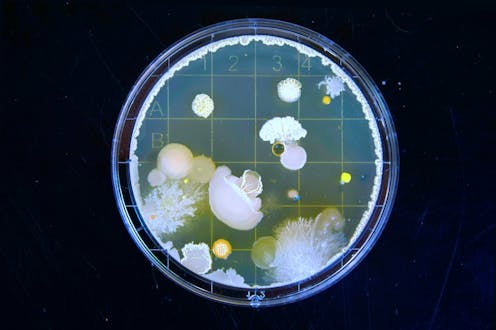Source: The Conversation (Au and NZ) – By Jonathan Symons, Macquarie School of Social Sciences, Macquarie University
Life has transformed our world over billions of years, turning a dead rock into the lush, fertile planet we know today. But human activity is currently transforming Earth again, this time by releasing greenhouse gases that are driving dramatic changes in our climate.
What if we could harness the power of living organisms to help rein in climate change? The field of “engineering biology”, which uses genetic technology to engineer biological tools for solving specific problems, may be able to help.
Perhaps the most dramatic success to date of this nascent field is the mRNA vaccines that helped us weather the COVID pandemic. But engineering biology has enormous potential not only to help us adapt to climate change, but also to limit warming.
In our latest paper in Nature Communications, we reviewed some of the many ways engineering biology can aid the fight against climate change – and how governments and policy makers can make sure humanity reaps the benefits of the technology.
Could engineering biology help fight climate change?
We identified four ways engineering biology might help to mitigate climate change.
The first is finding better ways to make synthetic fuels that can directly replace fossil fuels. Many existing synthetic fuels are made from high-value crops such as corn and soybeans that might otherwise be used for food, so the fuels are expensive.
Some engineering biology research explores ways to make synthetic fuel from agricultural waste. These fuels could be cheaper and greener, and so might help speed up decarbonisation.
For example, it would be much faster for airlines to decarbonise their existing fleets by switching to synthetic zero-carbon jet fuels, rather than waiting to replace their aircraft with yet-to-be-developed planes running on hydrogen or batteries.

Kevin Woblick / Unsplash
The second is developing cost-effective ways to capture greenhouse emissions (from industrial facilities, construction and agriculture) and then use this waste for “biomanufacturing” valuable products (such as industrial chemicals or biofuels).
The third is replacing emissions-intensive production methods. For example, several companies are already using “precision fermentation” to produce synthetic milk that avoids the dairy industry’s methane emissions. Other companies have produced microbes which promise to fix nitrogen in soil, and so help reduce use of fertilisers produced from fossil fuels.
Finally, the fourth is directly capturing greenhouse gases from the air. Bacteria engineered to consume atmospheric carbon, or plants bred to sequester more carbon in their roots, could in theory help reduce greenhouse gas levels in the atmosphere.
Beyond the technological and economic barriers, it’s unclear whether these ideas will ever gain a social license. Given the “science fiction-like” character of some of these emerging climate responses it’s essential that researchers be transparent and responsive to public attitudes.
Fact or science fiction?
Just how realistic are these ideas? Bringing a new product to market takes time, money and careful research.
Take solar power, for example. The first solar cell was created in the 1880s, and solar panels were installed on the White House roof in 1979, but it took many more decades of government support before solar power became a cost-competitive source of electricity.

Lincoln Electric Systems / Unsplash
The engineering biology sector is currently flooded with investor capital. However, the companies and projects attracting most investment are those with the greatest commercial value – typically in the medical, pharmaceutical, chemical and agricultural sectors.
By contrast, applications whose primary benefit is to reduce greenhouse emissions are unlikely to attract much private investment. For example, synthetic jet fuel is currently much more expensive than traditional jet fuel, so there’s no rush of private investors seeking to support its commercialisation.
Government (or philanthropic) support of some kind will be needed to nurture most climate-friendly applications through the slow process of development and commercialisation.
Back to picking winners?
Which engineering biology applications deserve governments’ assistance? Right now, it’s mostly too early to tell.
Policymakers will need to continually assess the social and technical merits of proposed engineering biology applications.
If engineering biology is to play a significant role in fighting climate change, policymakers will need to engage with it skilfully over time.
We argue government support should include five elements.
First, continued funding for the basic scientific research that generates new knowledge, and new potential mitigation tools.
Second, public deliberation on engineering biology applications. Some new products – such as precision-fermented synthetic milk – might gain acceptance over time even if they at first seem unattractive. Others might never gain support. For this public deliberation to reflect the interests of all humanity, low- and middle-income countries will need to gain expertise in engineering biology.

Photoongraphy / Shutterstock
Third, regulations should be aligned with public interest. Governments should be alert to the possibility of existing industries trying to use regulations to lock out new competitors. For instance, we may see efforts from animal-based agricultural producers to restrict who can use words like “milk” and “sausage” or to ban lab-grown meat completely.
Fourth, support commercialisation and scale-up of promising technologies whose primary benefit is reducing greenhouse emissions. Governments might either fund this work directly or create other incentives – such as carbon pricing, tax credits or environmental regulations – that make private investment profitable.
Fifth, long-term procurement policies should be considered where large-scale deployment is needed to achieve climate goals. For example, the US Inflation Reduction Act provides unlimited tax credits to support direct air capture. While these incentives weren’t designed with engineering biology in mind, they are technologically neutral and so might well support it.
A bioengineered future in Australia?
Governments are now involved in a global race to position their countries as leaders in the emerging green economy. Australia’s proposed “future made in Australia” legislation is just one example.
Other governments have specific plans for engineering biology. For example, the United Kingdom committed £2 billion (A$3.8 billion) last year to an engineering biology strategy, while the US CHIPS and Science Act of 2022 called for the creation of a National Engineering Biology Research and Development Initiative.
If such interventions are to be economically and ecologically successful, they will need to work with still-developing technology.
Can policymakers work with this kind of uncertainty? One approach is to develop sophisticated assessments of the potential of different technologies and then invest in a diverse portfolio, knowing many of their bets will fail. Or, they might create technology-neutral instruments, such as tax credits and reverse auctions, and allow private industry to try to pick winners.
Engineering biology promises to contribute to a major step up in climate mitigation. Whether it lives up to this promise will depend on both public and policymakers’ support. Given just how high the stakes are, there’s work for all of us to do in reckoning with this technology’s potential.
![]()
Jonathan Symons is an Associate Investigator with the Australian Research Council (ARC) Centre of Excellence in Synthetic Biology, Macquarie University, Sydney and part of a team that has received a Seed Grant from the Centre for work exploring “Future dairy: Australia’s cattle imaginaries”.
Jacqueline Dalziell is an Associate Investigator with the ARC Centre of Excellence in Synthetic Biology, Macquarie University. She is part of a team that has received a Seed Grant from the Centre for work exploring “Future Dairy: Australia’s Cattle Imaginaries.”
Thom Dixon is a PhD Candidate with the ARC Centre of Excellence for Synthetic Biology and the Macquarie University School of Social Science. He is Vice President with the Australian Institute of International Affairs NSW, and works full-time at Macquarie University.
– ref. Should we fight climate change by re-engineering life itself? – https://theconversation.com/should-we-fight-climate-change-by-re-engineering-life-itself-227995







